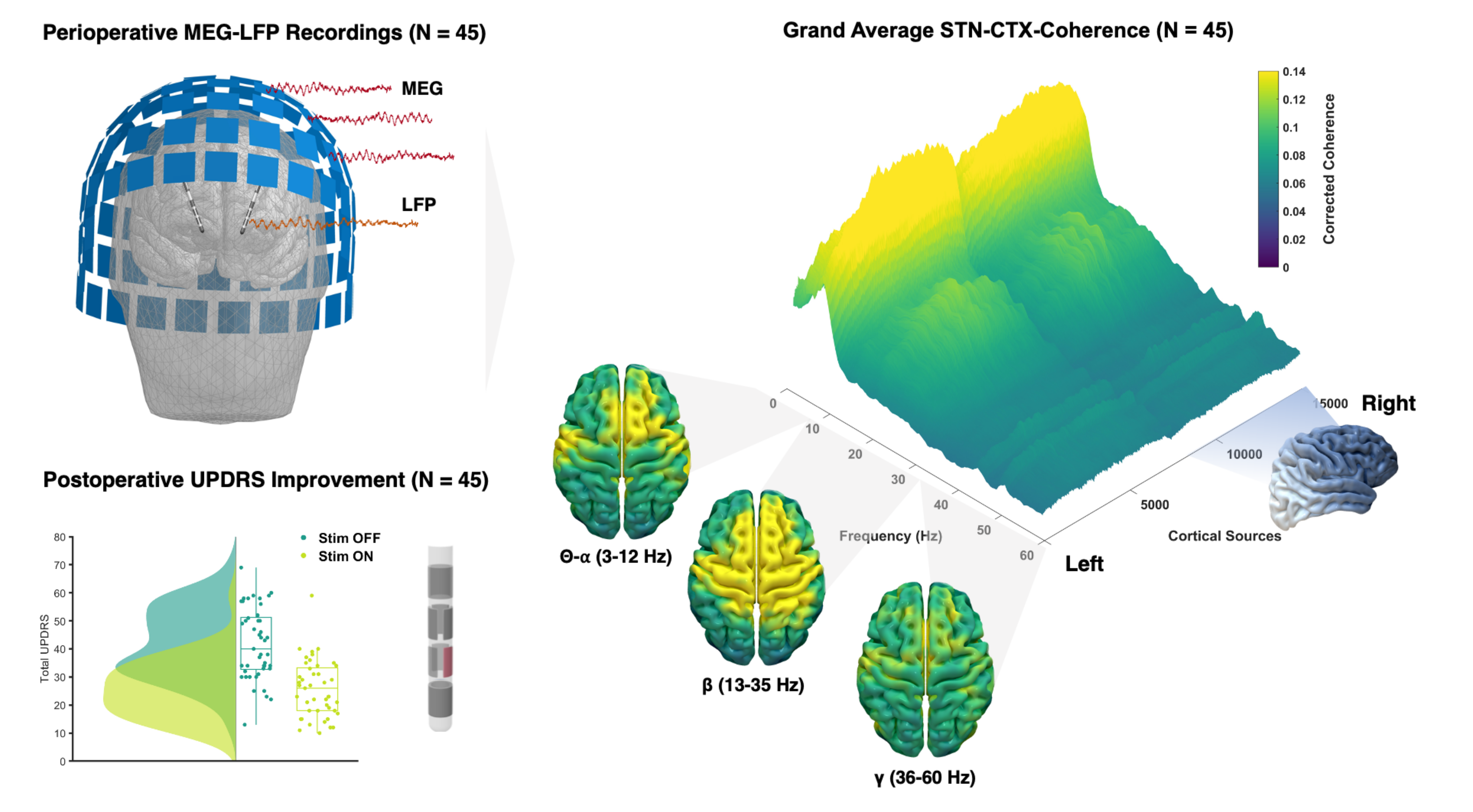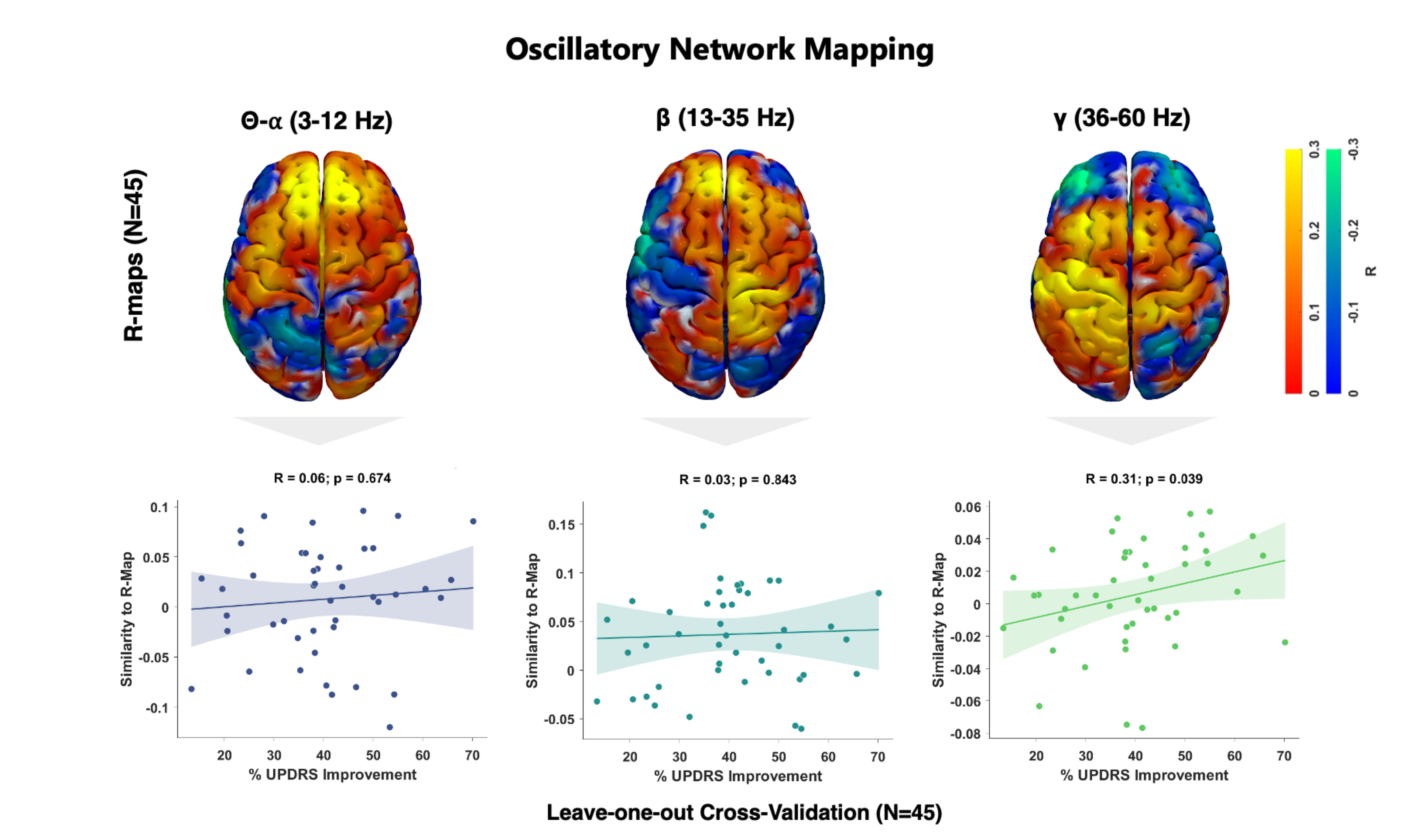Category: Parkinson's Disease: Neurophysiology
Objective: Use combined local field potential (LFP) and Magnetoencephalography (MEG) recordings to map whole-cortex oscillatory connectivity and estimate deep brain stimulation (DBS) outcome.
Background: Subthalamic (STN) DBS is an effective surgical treatment for advanced stages of Parkinson’s disease. Functional connectivity between STN and cortical fMRI time series allows to estimate individual DBS outcome[1]. However, fMRI has a low temporal resolution in relation to the neural processes underlying motor symptoms in Parkinson’s disease[2]. Recently, the role of cortico-STN coherence in estimating postoperative DBS outcome has been highlighted[3].
Method: Simultaneous MEG-LFP recordings (N=45) were gathered from previous studies[3–5] and cortico-STN coherence was computed between LFP at the chronic DBS contact and 15,000 cortical sources (Fig.1). Coherence spectra were corrected to account for the different degrees of freedom resulting from different data lengths as previously described[6]. We correlated the coherence maps for three frequency bands (theta-alpha, beta and gamma) with the percentage UPDRS improvement in a voxel-wise fashion[1]. The resulting correlation maps (R-maps) were spatially correlated with the coherence maps in a leave-one-out fashion.
Results: The coherence analysis revealed strong synchronization between the motor network and the STN in the beta-band. Theta-alpha coherence mapped to prefrontal and temporal cortices. Gamma coherence involved a broader network (Fig.1). Better outcomes were associated with a higher connectivity to the motor cortex and the supplementary motor area across frequency bands. The similarity of individual coherence maps to the gamma R-map was associated with UPDRS improvement (R=0.31, p =0.039).
Conclusion: We present a novel oscillatory network mapping approach that we use to identify optimal oscillatory connectivity profiles for DBS outcome. Only the optimal gamma-coherence maps showed an association with DBS outcomes across the cohort. Further investigation is needed to test our full cohort model on an additional independent dataset. To our knowledge, with 45 patients included, this is the largest MEG-LFP dataset studied so far.
Figure 1. Cortico-Subthalamic Coherence.
Figure 2. Oscillatory Network Mapping Analysis.
References: [1] Horn A, Reich M, Vorwerk J, Li N, Wenzel G, Fang Q, et al. Connectivity predicts deep brain stimulation outcome in Parkinson disease. Ann Neurol 2017;82:67–78. https://doi.org/10.1002/ANA.24974.
[2] Schnitzler A, Gross J. Normal and pathological oscillatory communication in the brain. Nat Rev Neurosci 2005 64 2005;6:285–96. https://doi.org/10.1038/nrn1650.
[3] Hirschmann J, Steina A, Vesper J, Florin E, Schnitzler A. Neuronal oscillations predict deep brain stimulation outcome in Parkinson’s disease. Brin Stimul 2022;0. https://doi.org/10.1016/J.BRS.2022.05.008.
[4] Sharma A, Vidaurre D, Vesper J, Schnitzler A, Florin E. Differential dopaminergic modulation of spontaneous cortico–subthalamic activity in parkinson’s disease. Elife 2021;10. https://doi.org/10.7554/ELIFE.66057.
[5] van Wijk BCM, Neumann W-J, Kroneberg D, Horn A, Irmen F, Sander TH, et al. Functional connectivity maps of theta/alpha and beta coherence within the subthalamic nucleus region. NeuroImage 2022;257:119320. https://doi.org/10.1016/J.NEUROIMAGE.2022.119320.
[6] Florin E, Pfeifer J, Visser-Vandewalle V, Schnitzler A, Timmermann L. Parkinson subtype-specific Granger-causal coupling and coherence frequency in the subthalamic area. Neurosci 2016;332:170–80. https://doi.org/10.1016/j.neuroscience.2016.06.052.
To cite this abstract in AMA style:
B. Bahners, M. Sure, L. Goede, K. Butenko, C. Hartmann, J. Hirschmann, J. Vesper, T. Sander, GH. Schneider, A. Schnitzler, A. Kühn, E. Florin, A. Horn. Oscillatory network mapping of deep brain stimulation outcomes in Parkinson’s disease [abstract]. Mov Disord. 2024; 39 (suppl 1). https://www.mdsabstracts.org/abstract/oscillatory-network-mapping-of-deep-brain-stimulation-outcomes-in-parkinsons-disease/. Accessed January 5, 2026.« Back to 2024 International Congress
MDS Abstracts - https://www.mdsabstracts.org/abstract/oscillatory-network-mapping-of-deep-brain-stimulation-outcomes-in-parkinsons-disease/


